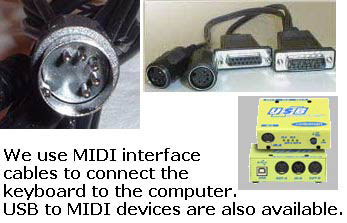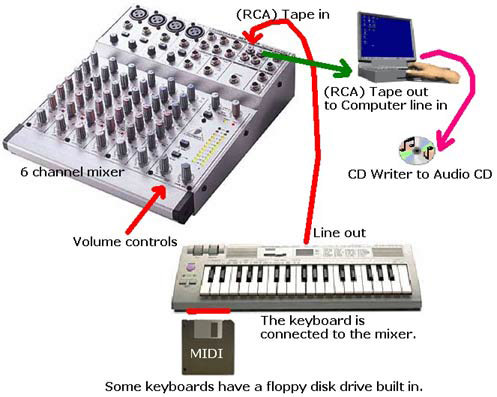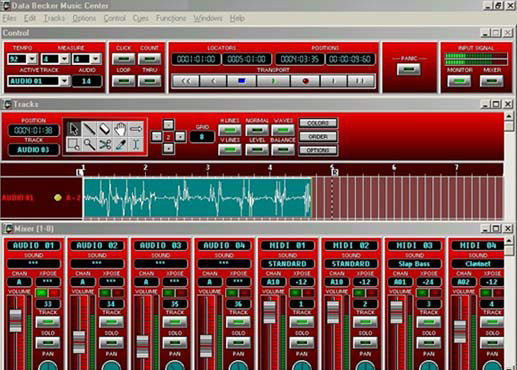Lesson Plans Page
Print this Lesson PDF (188 KB)
After studying MIDI and Sound Waves, students want to know the
process of making a CD. There are many ways to make CD's.
The following is the method that we use for making CD's
from the students' MIDI compositions.
Lesson 007
Objectives:
*Students will complete their own composition (ABA song
form, C Major scale, 32-60 measures) using the keyboard and
sequencing software on the computer to playback the song.
*To
continue working on pp. 22-35 or more in the Alfred Basic Piano
Library Level 1A (varies based on student level).
*To complete one or more Lessons in Music Ace 1.
*To complete one or more quizzes on our web site and report
scores to the teacher.
*To complete a study on how to transfer students' compositions
from MIDI file to CD Audio files.
Materials:
Alfred 1A Piano
Books, keyboards and related equipment, computers (with
or without Internet access), printer, Sibelius or Music Time Deluxe
and Music Ace 1 software and teacher's manual, music mixer,
CD-R disks, necessary audio cables for transfer of music
from keyboard to mixer / computer, Data Becker Music Center
software. (2006 - We have changed to Sony's Acid Music Studio for editing software.)
Procedures:
Review the differences in MIDI and sound wave files.
MIDI files have to be converted to sound waves using a
mixer and other instrument, such as a keyboard, to record
the file as a sound wave into the computer before it can
be recorded to a CD.
Students will start by saving their MIDI composition onto a floppy disk. We will take the disk with the MIDI file and insert into the floppy drive built-in to a General MIDI keyboard. We do this because our computer cannot have two different MIDI/audio software programs open at the same time by our sound card. The keyboard is connected to a small mixer which can (more adequately) control the volume of the keyboard going into the computer. We will use a recording program, such as Music Center (Data Becker) or Acid Music Studio (Sony) to record the music into the computer as a wave file from the keyboard. Students will hear the composition as the keyboard sounds when it is playing (as opposed to hearing the sound from the computer's sound card). We will use Music Center to 'trim' any extra sound before and after the song, leaving 2 or 3 seconds of silence at each end of the song. We are now ready to use our CD writer to save the wave files to a CD-R. We will make an audio CD, not a data CD. Audio CD's can be played in a regular CD player or on the computer. Students will create and print labels for their CD and will take them home to give to their families. Please note that after their 'first CD' is created and taken home, the excited students will want to make one each week. (See pictures below of keyboard / mixer / computer connections.) As of 2006, we use Sony's Acid Music Studio to edit wav files and convert files to MP3's.


Ask
students to notice...
-What kinds of music would you classify your song? i.e. modern, jazz, classical,
etc.
-Does your CD sound differently than you thought it would sound when you
recorded the MIDI file?
-Does your song have any patterns or sections outside of the ABA form?
-What student created your 'favorite song' in your group? Why
did you like it?
-Are sound waves larger in file size than MIDI files? (Yes, much
larger)
-Why would it be difficult to place the wave file (instead of MIDI) on
our web sites?
-Why should we use the mixer to connect the actual sound from the keyboard
into the computer?
-What will your next song include that you didn't have in the first song?
i.e. percussion, other instruments.
-Did you notice any dynamic changes to your first song? (No) Why? (our
keyboards do not have touch sensitive keys).
Data
Becker Music Center Software

